BigFoot Networks Killer NIC: Killer Marketing or Killer Product?
by Gary Key on October 31, 2006 2:00 AM EST- Posted in
- Networking
Gaming Performance
As usual, gaming performance was tested with a variety of current games. We ran benchmarks at our standard 1280x1024 resolution. Given the number of users that run 19 inch LCDs these days, 1280x1024 represents one of the most commonly used resolutions at this time.
Battlefield 2
This benchmark is probably the most intense one we ran as it occurred on the Daqing Oilfield map with 64 players battling it out in a chaotic frenzy. This was also the most difficult map we had to experience from a viewpoint of keeping our players together and trying to accomplish the same tasks. If you saw two players constantly missing the vehicle rides and spending a lot of time in the trees sniping then it was us. We ran Battlefield 2 using the highest quality graphics settings available in the video settings. The game itself is best experienced with average in-game frame rates of 40 and up.
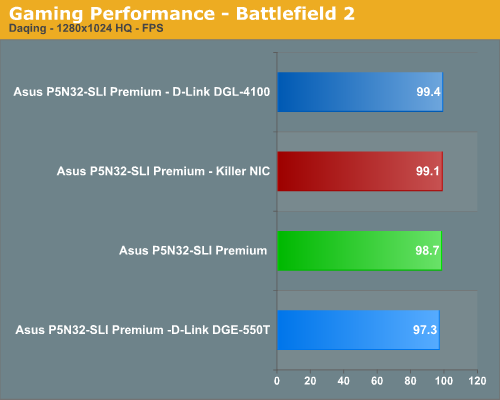

In our first game we actually find our D-Link combination performing slightly better than the other solutions from a benchmark viewpoint. During actual game play we noticed the frame rates and general smoothness of the system was best on the NVIDIA nForce 590SLI and followed closely by the Killer NIC. Several times during our testing with the D-Link DGL-4100 we would see several pauses while vehicles passed or several characters were in close proximity of each other. This behavior was worse on the D-Link DGE-550T when GameFuel was disabled on the router. In our first game we do not see $279.99 worth of game play improvement and the Killer NIC certainly did not allow us to dominate.
F.E.A.R.
We played both the Asylum and Deadwood 16-player maps. We decided to report the Asylum results as this is our favorite map currently. The Deadwood map generated similar results so we are not hiding any information. F.E.A.R. is a very graphics intensive game and we switch all graphic settings to maximum (except for soft shadows, which are disabled). An average frame rate for F.E.A.R. can dip into the teens at times which is not good for a first person shooter. We still found the game playable around 35fps or above in multiplayer.
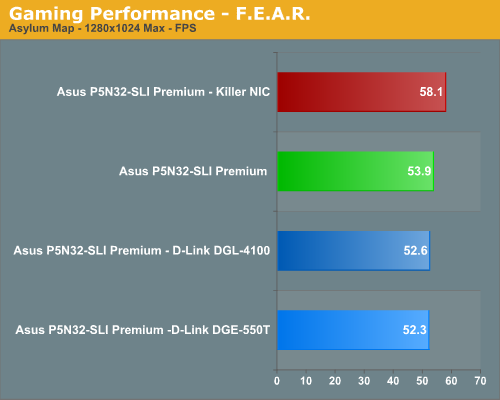

This is the money title for the Killer NIC. BigFoot Networks ships a copy of F.E.A.R. with every card so it should be expected to offer better frame rates and ping rates. We see a 7% increase in frame rates over the NVIDIA nForce 590SLI NIC and a 10% increase over the D-Link combination. In actual game play we found the Killer NIC to offer the most fluid experience and our ability to quickly transverse the map actually felt smoother than the other two solutions. The ping rates were actually higher than the D-Link router and nForce 590SLI but we did not find ping rate making a huge difference in this game. The question is did the Killer NIC improve our game play or skills? It really did not but it could for those who are significantly better players at this game than we are currently. In this case we will chalk a point up for the Killer NIC for improving frame rates.
Quake 4
This game should be a significant test for the Killer NIC as it requires extremely good hand to eye coordination along with lightning fast reflexes. This is just the game that would truly benefit from both improved ping and frame rates. We played on the Campgrounds Redux map with a total of 16 players. This is our favorite map from Quake III Arena and we were glad to see it return. We set our video settings to high and then fired up the game.
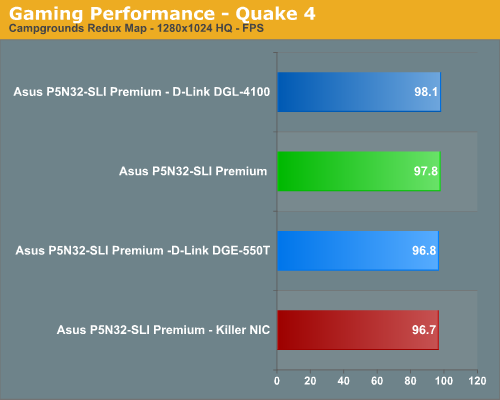
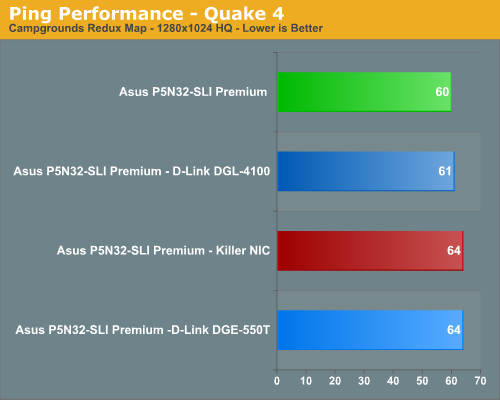
Actually, Quake 4 limits true frame rate to 60 fps during game play whether or not VSync is enabled. However, various timedemos and FRAPS will report the frame rate your system is capable of providing without the cap. In this case, we believe due to the speed of the game that ping rate is an extremely important performance measurement. This is one game where the Killer NIC loses on both fronts and it is mainly attributable to the excellent network code already provided in the game engine that does not benefit from offloading technology. The current performance leads us to believe we can expect to see the same results in the eagerly awaited Enemy Territory: Quake Wars.
Counter Strike Source
This is another game that BigFoot Networks touts as a premier title that will show improvements in both frame and ping rates. We are playing on the Office map with 32 players and we varied our online session times to ensure we were playing on a full server. Our settings were once again set to high quality at a 1280x1024 resolution. We find the game is very playable at 50 fps or better.
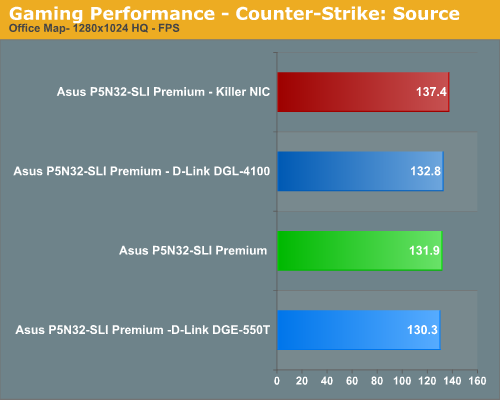

We did see frame rate improvements between three to five percent in this game. However, at these frame rates we really do not think a difference of 5% is going to matter much. Like Quake 4, an excellent ping rate in this game will make a difference and in this case we just did not see a large enough variation to make a difference in our experience. The Killer NIC did provide a positive experience to some degree in CSS as game play seemed to be a little smoother after firing your weapon than our other solutions. It was not a fire, frame hitch, and then move event we experienced a few other times during testing, especially with the D-Link PCI NIC. The Killer NIC gets a point for improving frame rates as advertised. We have to take it away for failing to improve our ping rates in a game where UltimatePing (reducing ping rates on the host system) could make a difference in actual game play.
Call of Duty 2
This is another popular shooter where frame rate and ping rate are very important especially in close quarters fighting. We played on the Caen map with a 24 player limit. The amount of packet processing this game generates is significantly higher at times than Counter Strike: Source so we expected our Killer NIC to shine in this area. Our video resolution is set to 1280x1024 with all options but AA enabled. We find the game is generally playable with a 40 fps or higher rate in multiplayer.
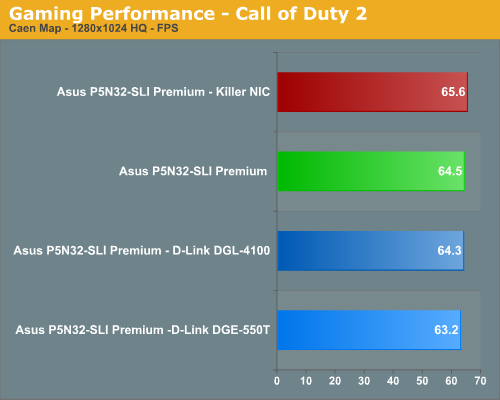
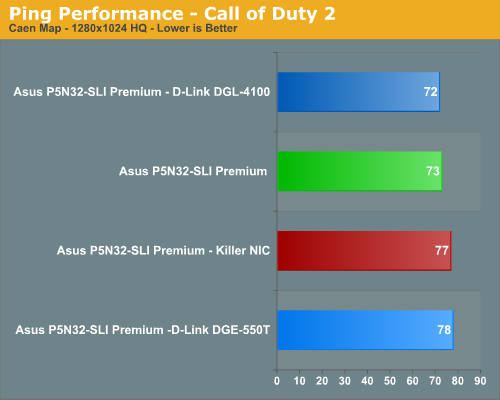
These results surprised us as we see minor frame rate improvements but ping rates were up to 7% greater than our D-Link router or NVIDIA NIC. The frame rate improvement is only worth mentioning because this game is generally GPU bound so any benchmark differences between systems is noticeable. Were the frame rate differences during game play noticeable? No they were not but we can tell you the increased ping rates were noticeable. This was the first game we encountered where the actual game play was not smooth with the Killer NIC. We noticed choppy break points at certain sections, especially when going building to building in the center of the map. We tried this map at different times during the day and noticed this issue several times. It seemed to be worse when throwing a grenade as we blew our selves up twice during testing. We might be slow and have weak arms in real life but our game characters did not need this handicap.
As usual, gaming performance was tested with a variety of current games. We ran benchmarks at our standard 1280x1024 resolution. Given the number of users that run 19 inch LCDs these days, 1280x1024 represents one of the most commonly used resolutions at this time.
Battlefield 2
This benchmark is probably the most intense one we ran as it occurred on the Daqing Oilfield map with 64 players battling it out in a chaotic frenzy. This was also the most difficult map we had to experience from a viewpoint of keeping our players together and trying to accomplish the same tasks. If you saw two players constantly missing the vehicle rides and spending a lot of time in the trees sniping then it was us. We ran Battlefield 2 using the highest quality graphics settings available in the video settings. The game itself is best experienced with average in-game frame rates of 40 and up.


In our first game we actually find our D-Link combination performing slightly better than the other solutions from a benchmark viewpoint. During actual game play we noticed the frame rates and general smoothness of the system was best on the NVIDIA nForce 590SLI and followed closely by the Killer NIC. Several times during our testing with the D-Link DGL-4100 we would see several pauses while vehicles passed or several characters were in close proximity of each other. This behavior was worse on the D-Link DGE-550T when GameFuel was disabled on the router. In our first game we do not see $279.99 worth of game play improvement and the Killer NIC certainly did not allow us to dominate.
F.E.A.R.
We played both the Asylum and Deadwood 16-player maps. We decided to report the Asylum results as this is our favorite map currently. The Deadwood map generated similar results so we are not hiding any information. F.E.A.R. is a very graphics intensive game and we switch all graphic settings to maximum (except for soft shadows, which are disabled). An average frame rate for F.E.A.R. can dip into the teens at times which is not good for a first person shooter. We still found the game playable around 35fps or above in multiplayer.


This is the money title for the Killer NIC. BigFoot Networks ships a copy of F.E.A.R. with every card so it should be expected to offer better frame rates and ping rates. We see a 7% increase in frame rates over the NVIDIA nForce 590SLI NIC and a 10% increase over the D-Link combination. In actual game play we found the Killer NIC to offer the most fluid experience and our ability to quickly transverse the map actually felt smoother than the other two solutions. The ping rates were actually higher than the D-Link router and nForce 590SLI but we did not find ping rate making a huge difference in this game. The question is did the Killer NIC improve our game play or skills? It really did not but it could for those who are significantly better players at this game than we are currently. In this case we will chalk a point up for the Killer NIC for improving frame rates.
Quake 4
This game should be a significant test for the Killer NIC as it requires extremely good hand to eye coordination along with lightning fast reflexes. This is just the game that would truly benefit from both improved ping and frame rates. We played on the Campgrounds Redux map with a total of 16 players. This is our favorite map from Quake III Arena and we were glad to see it return. We set our video settings to high and then fired up the game.


Actually, Quake 4 limits true frame rate to 60 fps during game play whether or not VSync is enabled. However, various timedemos and FRAPS will report the frame rate your system is capable of providing without the cap. In this case, we believe due to the speed of the game that ping rate is an extremely important performance measurement. This is one game where the Killer NIC loses on both fronts and it is mainly attributable to the excellent network code already provided in the game engine that does not benefit from offloading technology. The current performance leads us to believe we can expect to see the same results in the eagerly awaited Enemy Territory: Quake Wars.
Counter Strike Source
This is another game that BigFoot Networks touts as a premier title that will show improvements in both frame and ping rates. We are playing on the Office map with 32 players and we varied our online session times to ensure we were playing on a full server. Our settings were once again set to high quality at a 1280x1024 resolution. We find the game is very playable at 50 fps or better.


We did see frame rate improvements between three to five percent in this game. However, at these frame rates we really do not think a difference of 5% is going to matter much. Like Quake 4, an excellent ping rate in this game will make a difference and in this case we just did not see a large enough variation to make a difference in our experience. The Killer NIC did provide a positive experience to some degree in CSS as game play seemed to be a little smoother after firing your weapon than our other solutions. It was not a fire, frame hitch, and then move event we experienced a few other times during testing, especially with the D-Link PCI NIC. The Killer NIC gets a point for improving frame rates as advertised. We have to take it away for failing to improve our ping rates in a game where UltimatePing (reducing ping rates on the host system) could make a difference in actual game play.
Call of Duty 2
This is another popular shooter where frame rate and ping rate are very important especially in close quarters fighting. We played on the Caen map with a 24 player limit. The amount of packet processing this game generates is significantly higher at times than Counter Strike: Source so we expected our Killer NIC to shine in this area. Our video resolution is set to 1280x1024 with all options but AA enabled. We find the game is generally playable with a 40 fps or higher rate in multiplayer.


These results surprised us as we see minor frame rate improvements but ping rates were up to 7% greater than our D-Link router or NVIDIA NIC. The frame rate improvement is only worth mentioning because this game is generally GPU bound so any benchmark differences between systems is noticeable. Were the frame rate differences during game play noticeable? No they were not but we can tell you the increased ping rates were noticeable. This was the first game we encountered where the actual game play was not smooth with the Killer NIC. We noticed choppy break points at certain sections, especially when going building to building in the center of the map. We tried this map at different times during the day and noticed this issue several times. It seemed to be worse when throwing a grenade as we blew our selves up twice during testing. We might be slow and have weak arms in real life but our game characters did not need this handicap.










87 Comments
View All Comments
Gary Key - Wednesday, November 1, 2006 - link
We tested these two cards as part of our Killer NIC testing routine. We did not report the numbers as they did not vary greatly from the NIVIDA 590SLI NIC solution.Crassus - Wednesday, November 1, 2006 - link
Sorry, but that plus the server test would have been very useful information I would have liked in the review. Or maybe we can have a different review, sort of a "NIC roundup". If your results are the same across the board, it's a finding worth mentioning as well, isn't it?Frumious1 - Tuesday, October 31, 2006 - link
I bet it doesn't even beat the onboard NVIDIA NIC. Or rather, it will tie the NVIDIA solution, which means it's equal to the Killer in most situations and fractionally slower in a few games. Maybe it has lower CPU usage when doing gigabit transmits, but high bandwidth with low CPU usage isn't going to matter much for gaming. Not that any NIC related stuff matters much for gaming these days.vaystrem - Tuesday, October 31, 2006 - link
I agree its very difficult to test NIC performance and kudos to Anandtech for trying. But, it seems to me that using the card as a server for the games where it saw the most improvement, Fear/CS, and even for those that it didn't may be more enlightening than exploring the client side of things.Gary Key - Tuesday, October 31, 2006 - link
We set up one of our test beds as a server for a couple of the games we tested. The performance was actually worse than our NVIDIA NIC (dualnet/teaming), Intel PRO/1000 PT, and barely did better than our D-Link PCI NIC in half of the tests. We will not fault the card for its peformance since it was specifically designed as a client side card. This very well could change in the future due to their ability to optimize driver code on the FPGA unit. The article could have gone another five pages with the server and LAN tests that we completed (neither showed any significant differences). It appears from several of the comments that anything over three pages was a waste anyway. ;-)EODetroit - Tuesday, October 31, 2006 - link
Except according to the PR material the card is made for game clients, not optimized for game servers.VooDooAddict - Tuesday, October 31, 2006 - link
While the POSIBILITY of embeded linux apps is interesting. For someone who would have the $$ do buy this ... they would have the money to put inexpensive PC parts together into a linux machine. Likely they have spare parts leftover from thier last upgrade.Anyone else think the company name is strangly fitting? "BigFoot" ... Myth and Hype?
Certainly not saying a nice NIC isnt'a good investment ... but at almost $300 ... it's a joke. Drop the embedded linux, hit the $50 price point and this thing would probably sell like mad to WoW Addicts. (eventually also have a PCIe version)
The aegia(sp?) physics processor is the same way. Great concept, but the tangable benefits are so minimal for the price. $300 Video cards took off because there was a tangable benefit.
Dropping anothre $300 into the Storage System, Monitor, CPU, Video card, RAM, or even Audio system (surround speakers) would give one a much mroe imersive experience.
Someone made the wrong decission to stick with the embedded linux thing. Seriously a sperate leftover parts Linux box and a DLINK 4100 router would be a far better way to go.
So any guesses as to the next $300 (*caugh* gimic *caugh*) expendature to "improve" gaming?
For those comparing this to SLI/Crossfire. SLI and Crossfire can offer substantial image quality enhancements for people with large pixel count LCDs. The ability to run LCDs at native resolution for gaming is a very tangable benefit. Not something everyone agrees it worth the $$. But the benefit is there.
VooDooAddict - Tuesday, October 31, 2006 - link
I was really hoping for somethign major from this card ... just from the perspective of reliving history.Around 10 years ago now (back around '96-'97) when NICs weren't build onboard spending $60-$70 on a 3Com 3c905 or a server class Intel NIC would make a bug differance in overall system performace when working with the Internet, LAN, and Gaming. They gave me big advantages over anyone who just went out an bought a cheapo $20 NE2000 comptable NIC (16-bit ISA even!).
I'm talking Quake 1, Duke3D, Quake 2, Quake CTF, Original Unreal... A single 3dFx VooDooGraphics Board + 3c905 = pwnage (back when "pwnage" was still a typo). I was so often accused of cheating by laptop wielding, software emulating, newbies (wasn't spelt "noob" then).
... That above is why I picked up the handle "VooDooAddict"
EODetroit - Tuesday, October 31, 2006 - link
And they deleted it. Claiming it needed to be moved from "Testimonials" to "General" forum. Whatever, but they didn't actually move my post, they deleted it and replaced it with a post of their own, with the link, plus quoted all the good things said in the Anandtech review and none of the bad. Typical and misleading, but hey, its their web site. They can do what they want. Still, misleading people doesn't endear them to anyone.LoneWolf15 - Tuesday, October 31, 2006 - link
I admire the amount of engineering that went into this product. It's obvious that the product isn't "snake oil" in the same way that, say, SoftRAM software was back in the day. There's a lot more to this card than just a NIC.That said, I don't think it provides enough benefit to justify $279 (unless perhaps you're making $50k+ a year in the PGL). Today's NICs are already pretty well optimized for most situations, plus many mainboard NICS are directly on the PCIe bus, something the Killer NIC can't offer (and as someone pointed out, try doing gig ethernet across a PCI slot; it really isn't feasible, especially if you already have the PCI bus shared with other components like a TV tuner or sound card). The Killer NIC's most interesting feature, FNApps, is not useful at the moment, and I'm still concerned that it might pose a security risk through a malformed application (that's assuming someone coded that app in the first place, considering how little marketshare the Killer NIC is likely to have). Like the Ageia PhysX, at this point in time, I don't see the justification.
P.S. Is it just me, or does the heatsink "K" look like a Klingon weapon? I'm thinking either Klingon brass-knuckles or a hybrid bat-lef. ;)